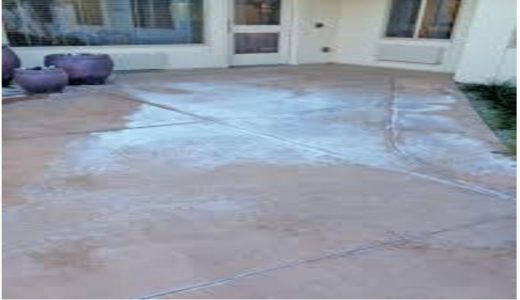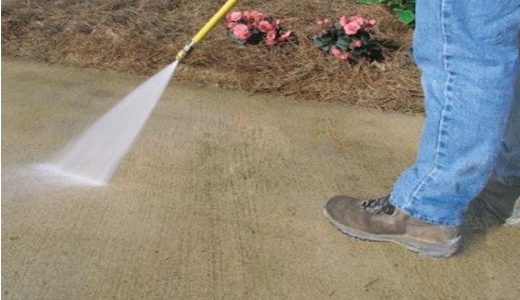What is Concrete Discoloration?
A simple definition of concrete discoloration is a shift away from the original color. The presence of calcium chloride in the concrete, cement, and additives, as well as problems with curing, weather, and poor workmanship, could all play a role. These causes of discoloration can be mitigated to some extent. However, steps can be taken to mitigate the effects of dark patches, strips, and blotchy concrete that a contractor may experience. Once the concrete has fully cured, the appropriate treatment method can be chosen based on the root of the discoloration.

Fig1: Concrete Discoloration
Courtesy: concreteconstructon.net
What are the Causes of the Discoloration of Concrete?
Following are some common causes of discoloration of concrete:
i) Inconsistent Materials:
Consistency in mixed proportions, in particular, is crucial for avoiding unfavorable color issues throughout the project. Disparities in the delivery of mixes from one batch to the next make it difficult to produce a concrete surface with a consistent hue.
Your ready-mix provider should provide you with a uniform concrete mixture. Nonetheless, that’s trickier than it sounds because each of the concrete’s many constituents has unique properties. Consistent interactions between the many constituents of a batch of concrete, including cement, supplemental cementitious materials, sand, stone, water, admixtures, and possibly fibers, do not occur “by chance.”
All of the concrete’s constituent parts must meet the ASTM standards. It is crucial to use high-quality aggregates in concrete. The amount of mixed water needed will vary depending on the moisture levels of the sand and stone. Failure to do so may have serious repercussions in the industry.
ii) Adding water on the Job Site:
On the job site, adding water to concrete to make it easier to work with is common. Most of the time, small differences in the amount of moisture don’t cause problems, but big differences will again cause discoloration.
iii) Change in Color of Cement:
The color of the cement sent to the ready-mix plant may change slightly depending on how the cement was burned or ground during production. A change in the color of the cement can cause a change in the color of the concrete. It may be noticeable if the cement is changed in the middle of placement or if this new mix is placed right next to concrete made with cement from a different source.
iv) Adding Calcium Chloride:
When calcium chloride is used to speed up the setting time of concrete, it can cause the concrete to take on a darker hue (see Image 1), especially at concentrations of about 2% by weight of cement. Color irregularities or blotchiness in concrete are exacerbated by inadequate mixing after adding calcium chloride
v) Replacements for Cement:
Because of the growing “green” movement, recycled items are increasingly being used as partial cement replacements, resulting in color differences depending on the recycled material percentage, the water-to-cementitious materials ratio, and the curing process.
Slag, steel industry waste, and fly ash from coal combustion are two examples of common recycled or supplemental cementitious materials (SCM). Colors from buff to brown can be achieved by using different amounts of fly ash. Using slag may cause temporary lightening of color, from a bluish or green hue at first. Mostly, a slag-cement mixture will be less dense than traditional concrete.
vi) Poor Quality of Work:
Before pouring concrete, contractors should consider the weather because it greatly affects the result. Water should be added to the subgrade before concrete is poured on top of the subgrade is dry.
If dry finishing is done while bleed water is still on the surface, the look of the concrete can change, and it can be harder to tell where one area ends and another begins. Also, putting down concrete in hot weather speeds up the evaporation rate, so it may be necessary to use evaporative retarders, windbreaks, or any other practices that are right for the situation.
vii) Placement of Objects on Concrete during the Initial Curing:
The surface color of colored concrete becomes blotchy and uneven when plastic, lumber, or building waste is left on it during curing. Curing difference is generated by varying moisture levels at the surface of the concrete in the critical initial few days to weeks after pouring. Thus, homogeneous curing is essential for consistent colored concrete surfaces. Concrete surface discoloration can be caused by plastic sheets used to cure concrete. Leopard spotting is caused by creases or air spaces in plastic covers or drying blankets.
How to Prevent Color Problems with Concrete?
- The concrete pouring molds you employ might also have an effect. If you switch them in the middle of the procedure, they may either soak up or push away the water. As a result, the moisture content and color may change.
- Reduce the amount of high-alkali cement you use, as it will inevitably discolor the concrete,
- Metal shards left in the concrete by trowel burning might corrode or discolor the concrete differently.
- The concrete must cure uniformly. Uneven drying can occur if a sheet is set on top of something moist, curing if it is touching in some spots and not in others.
- Eliminating the use of calcium chloride could also improve drying consistency.
How to Treat Discolored Concrete Surface?
Following are some of the treatment methods used to treat discolored concrete surfaces:
i) Cleansing:
It is recommended to flush the hardened surface with hot water and scrub with a fine brush to eliminate any light discoloration to even out the variance in moisture content and mineral accumulation of the concrete. Depending on the severity of the discoloration, this process may need to be done multiple times. As soon as the concrete is dry and any stains have faded away, a fresh, thin coat of concrete sealer should be applied to preserve the surface.
ii) Acid Treatment:
A mild acid solution, such as 1% to 3% muriatic acid, should be used for severe discoloration. A high quantity of muriatic acid leaves spots and weakens the concrete; thus, applying the proper proportion is important.
Flooding the concrete’s surface, waiting for it to dry and then applying the acid solution is a good way to regulate how far the acid penetrates the concrete. The acid solution might penetrate deeper into the concrete if allowed to dry out for longer. Because of this, operating on a manageable concrete surface and regulating acid penetration based on the drying time after flooding is recommended. If you apply an acid solution, you have 15 minutes to wash it off with clean water.
iii) Color-Tinted Sealer:
Concrete discoloration can be concealed with a tinted color sealer if washing the surface is unsuccessful and acid solutions are not desired. The material’s aesthetics won’t be compromised if a sealer seeps into the concrete, unlike acid solutions and acrylic sealers.
The acid creates a marble-like look, while the acrylic sealer darkens the surface and leaves behind a low-to-high gloss finish. Use a solvent-based acrylic sealer, and test a tiny area to ensure a consistent sheen before applying it. An acrylic sealer can be tinted to conceal the damage on the concrete surface entirely.
iv) Diammonium Citrate:
Diammonium citrate is a stronger option that is only used for major discoloring. The salt compound diammonium citrate is used to polish. Please wait 15 minutes after putting it on the concrete. Use a 30 percent water solution. Then it should be thoroughly brushed and rinsed.
vi) Special Coating:
It is possible to hide the discoloration and stain using a thin polymer-modified coating. Graffiti is typically painted over with this type of coating.

Fig2: Resurfacing of Concrete
Courtesy: forconstructionpros.com
vii) Resurfacing of Concrete:
If the discoloration and stains are bad and can’t be fixed properly, you can cover the messed-up color by putting a concrete overlay over the whole area.
Conclusion:
Discoloration of concrete is a source of discontent for the contractor and the owner. Large concrete parts could display different shades, while other places might exhibit early light efflorescence. If you want to keep the color of your concrete intact, you’ll need to study and plan ahead of time. Think about how much moisture is in the air, subgrade, and mixture when it is poured and allowed to cure. Don’t attempt to force things along. In the event of discoloration, tracking down its cause is essential for affecting a speedy repair.
References:
1. “Concrete Discoloration: How to Treat Discolored Concrete Surface? – Assignment Point.” Assignment Point, assignmentpoint.com/concrete-discoloration-how-to-treat-discolored-concrete-surface. Accessed 24 Oct. 2022.
2. “Concrete Discoloration: Drying Different Colors or Spotty – Concrete Network.” Concrete Discoloration: Drying Different Colors or Spotty – Concrete Network, www.concretenetwork.com/concrete-discoloration. Accessed 24 Oct. 2022.
3. https://www.concreteconstruction.net/how-to/construction/discolored-concrete-flatwork-the-causes-and-how-to-minimize_o. www.concreteconstruction.net/how-to/construction/discolored-concrete-flatwork-the-causes-and-how-to-minimize_o. Accessed 24 Oct. 2022.
4. “Discoloration — What, Why, and How? – Nevada Ready Mix.” Discoloration — What, Why, & How? – Nevada Ready Mix, www.nevadareadymix.com/concrete-tips/discoloration. Accessed 24 Oct. 2022.
5. Sullivan, Chris. “Concrete Surface Color Problems and How to Fix Them – Concrete Decor.” Concrete Decor, www.concretedecor.net/departments/staining-coloring/fixes-for-common-surface-color-problems. Accessed 24 Oct. 2022.
6. Concrete, R&M. “Why Is My Concrete Discoloring?” R&M Concrete, 10 Feb. 2019,randmconcrete.com/why-is-my-concrete-discoloring
If you have a query, you can ask a question here.


